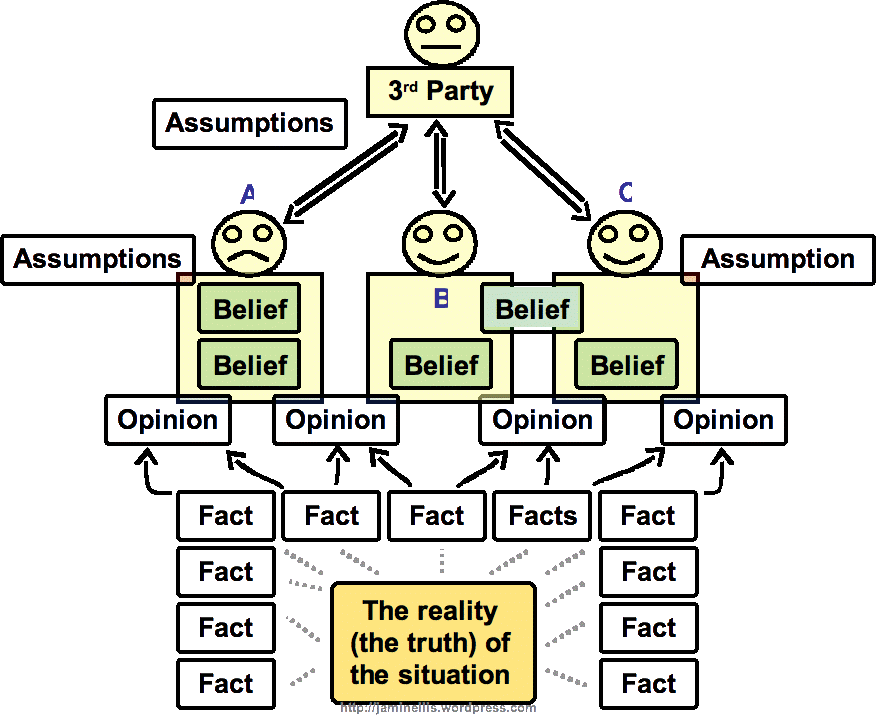Understanding the reality of the situation – Part II
(Continued from Part I) Where were we? Ah, yes! Understanding the reality of the situation. There are so many different challenges raised by this, I feel that I am only at the beginning. However, just one more post, then back to thoughts around to do lists, with some exciting breakthroughs on ThinkingRock.
I think the concept of their being a reality to any situation, which can be described by a set of facts, is a key foundation to getting a grip on life. The next step is understanding that we don’t perceive reality directly. We perceive the situation via other people’s words, as they describe what they have seen with their eyes and ears. A side note here: Even if we were there we don’t perceive the world directly ourselves, since we are also perceiving it via our our eyes and ears.
The senses can be funny things, they can be influenced by our assumptions and beliefs. If you are not sure what I mean, then think of a magic show that you might have seen, particularly something involving objects appearing or disappearing. That kind of magic, sometimes called close up magic, depends on the expectations of our brains overriding what our eyes really see, or misdirecting our eyes to one place. As that happens, we miss something being moved or hidden in another place. More often than not, we see what we want to see (because of Gestalt – see coincidence?). We also hear what we want to hear, again there is some experimental evidence for this. This tendency is something to be very conscious of when we are communicating with other people. We hear what we want to hear. They hear what they want to hear. Usually, nobody is any the wiser. For the modern knowledge worker, who deals almost exclusively in information, this can make work into hard work.
A thought experiment for you to try. In a minute, imagine a situation where we are in a near-by forest, right in the middle of February, standing on the ground facing the sun. Shut your eyes now, and imagine the sights, sounds and feelings. Done it? Was it nice there? Was it peaceful? Let’s compare notes. In my forest, there was a sprinkling of snow on the ground, it was dry and there was a row of brick houses behind me. At this point I have probably lost half of you. In the northern hemi-sphere, February is winter, in the south it is summer. Our experience creates assumptions of what February is. Your forest might have had no houses, or it might have had houses all around.
We have different experiences, which lead us to different expectations and assumptions about a situation. There are lots of reasons that our forest example is silly, we weren’t recalling the same situation of course, but you would be surprised how many details people fill in even when recalling a real situation.
Now, let’s go riding in the our forests. How is the ride? Are you on two wheels, four wheels or four legs? Notice how we fill in the blanks, it is just natural. If we didn’t, we would struggle to function. You can start to see why understanding the reality of a situation via a third party is so hard. Assumptions can sneak in and knock us off track. It is good to ask ourselves “that is interesting, how do I know that?” and “is that really the case?” at regular intervals. Not to cause us to doubt ourselves and get into a muddle, but to sift the facts from the assumptions, the beliefs.
Facts always have some form of proof or evidence. A fact stated without evidence is just an assertion, it is a claim that something is true, which requires further investigation. The speaker might not even think that it is a fact, it could be just speculation – a suggestion of what the facts might be. To be sure, we must find the evidence, we that supports the claim. For example, a news reader on TV says “Carbon dioxide is resulting in global warming, causing the polar ice caps to melt”. That is an assertion. How do we know it is the carbon dioxide causing the ice caps to melt? We may have video evidence of the ice caps melting, but the polar ice caps melt every year for a season, and then they reform. The idea that carbon dioxide is causing it is an assertion by the news reader. It happens to be a common, or ‘shared’ belief, so we are comfortable with it. It might be true, but how do we know it is true? Actually, we don’t, since all we have is some second hand opinions about it, based on some facts and some assumptions that we are probably unaware of. We take it on faith, trusting in what we have read or been told by people we often haven’t even met. Lots of people believe it to be true, but based on the diagram, does that give any more reason to believe that it actually is?

See also: Wikipedia – A Means not an End


[…] There are different theories about how we perceive what we see and hear. Some theories say we shape what we sense to fit our knowledge (experience, biases, expectations and the like). Other theories say we perceive the world more directly. Still others say that we perceive ‘wholeness’ – even if there isn’t quite a ‘whole’ to be perceived, we join up the dots (see “understanding the reality of the situation“). […]